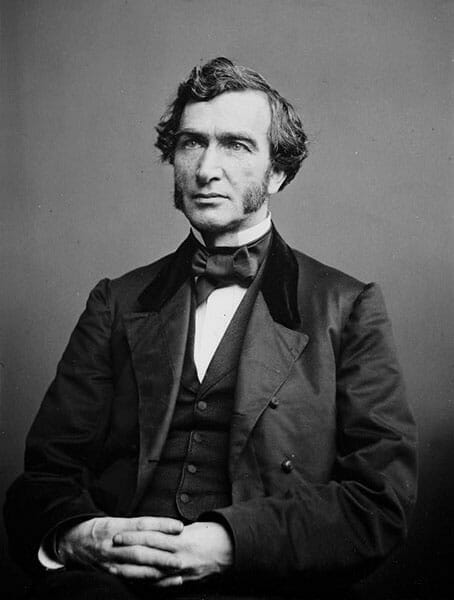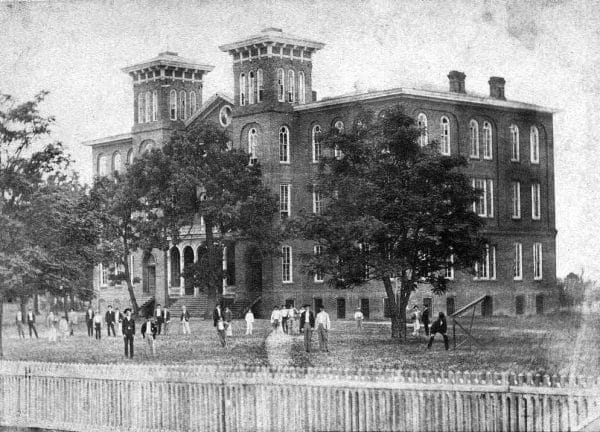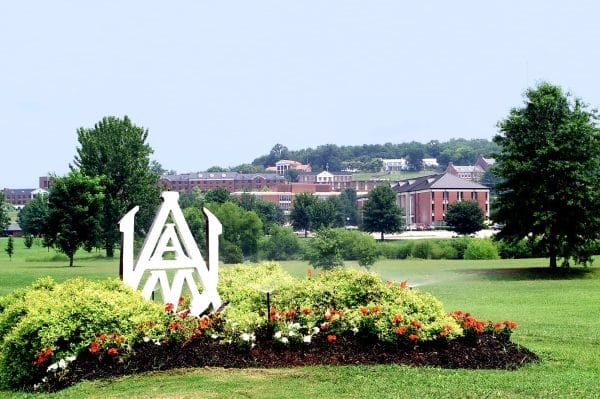Land Grant Colleges in Alabama
Alabama Agricultural and Mechanical University (Alabama A&M), Auburn University, and Tuskegee University are Alabama‘s land grant colleges. These institutions were created under the Morrill Acts, which were intended to improve agricultural education. Today, the institutions serve the state as well as the national and international communities with their research and outreach in many fields, including agriculture, engineering, and animal sciences.
 Justin Smith Morrill
Convinced that the United States was falling behind Europe in agricultural production and education, Vermont congressman Justin Smith Morrill proposed to the U.S. Congress, in an 1857 bill, that the federal government provide a means for the states to fund educational institutions to foster learning and research in agriculture and the mechanical arts. Congress approved Morrill’s bill in 1858, but it was vetoed by Pres. James Buchanan. Four years later, under new Pres. Abraham Lincoln, Morrill reintroduced the bill with an added proviso that military education be included in the new curriculum. Lincoln, unfettered by Buchanan’s constitutional reservations, signed the Morrill Act, as it came to be known, in July 1862. The act granted each state 30,000 acres of public land, to be chosen by the states, within the state borders for each representative and senator it had serving in Congress. The states could then sell the land and use the proceeds to establish colleges or universities whose primary function centered on educating people in better agricultural practices, “mechanical arts” (today called engineering), and military science. Enacted during the Civil War, the Morrill Act initially excluded those states in rebellion against the Union.
Justin Smith Morrill
Convinced that the United States was falling behind Europe in agricultural production and education, Vermont congressman Justin Smith Morrill proposed to the U.S. Congress, in an 1857 bill, that the federal government provide a means for the states to fund educational institutions to foster learning and research in agriculture and the mechanical arts. Congress approved Morrill’s bill in 1858, but it was vetoed by Pres. James Buchanan. Four years later, under new Pres. Abraham Lincoln, Morrill reintroduced the bill with an added proviso that military education be included in the new curriculum. Lincoln, unfettered by Buchanan’s constitutional reservations, signed the Morrill Act, as it came to be known, in July 1862. The act granted each state 30,000 acres of public land, to be chosen by the states, within the state borders for each representative and senator it had serving in Congress. The states could then sell the land and use the proceeds to establish colleges or universities whose primary function centered on educating people in better agricultural practices, “mechanical arts” (today called engineering), and military science. Enacted during the Civil War, the Morrill Act initially excluded those states in rebellion against the Union.
During Reconstruction, Congress amended the act in 1866 to permit former Confederate states to participate, and competing forces within Alabama began vying to locate the proposed institution within their region. Because Congress did not permit money generated from the Morrill Act to be used for constructing campus buildings, any proposal that included existing and ready-to-use buildings had an advantage in the selection process. In addition to the prestige that would come to the community chosen to host the college, an accompanying economic boost—courtesy of incoming students and their money—would also befall the lucky community.
Other federal legislation after the initial Morrill Act allowed states to expand their land-grant programs and outreach efforts. The Hatch Act of 1887 provided funds for establishing agricultural research stations. Shortly thereafter, the Morrill Act of 1890 provided for the creation of separate land-grant colleges for African Americans as well as annual cash appropriations for all land-grant colleges. Finally, the 1914 Smith-Lever Act allocated money for extension work. Three universities in Alabama would benefit from these legislative developments.
Auburn University
 Old Main
The East Alabama Male College had been struggling with financial difficulties since 1859 and even closed down during the Civil War. Alabama Methodists voted to donate the school to the state, and the townspeople of Auburn offered 100 acres if the legislature established a land-grant program at the school. Sheldon Toomer, who represented Lee County in the Alabama House of Representatives, and state senator J. L. Pennington of Lee County guided a bill through the legislature that made the former East Alabama Male College the site of the state’s land-grant college in 1872. Officials then re-christened the institution the Agricultural and Mechanical College of Alabama. It was renamed the Alabama Polytechnic Institute in 1899 and finally Auburn University in 1960.
Old Main
The East Alabama Male College had been struggling with financial difficulties since 1859 and even closed down during the Civil War. Alabama Methodists voted to donate the school to the state, and the townspeople of Auburn offered 100 acres if the legislature established a land-grant program at the school. Sheldon Toomer, who represented Lee County in the Alabama House of Representatives, and state senator J. L. Pennington of Lee County guided a bill through the legislature that made the former East Alabama Male College the site of the state’s land-grant college in 1872. Officials then re-christened the institution the Agricultural and Mechanical College of Alabama. It was renamed the Alabama Polytechnic Institute in 1899 and finally Auburn University in 1960.
Although historically known for its programs in agriculture, engineering, and the sciences, as well as its Reserve Officers Training Corps (ROTC) programs, Auburn maintained its East Alabama Male College roots and has continued to emphasize the importance of the liberal arts. Of the 13 schools and colleges that comprise the present university, the College of Liberal Arts is the largest.
Alabama A&M University
 William Hooper Councill Domestic Science Building
During the 1871-72 session of the Alabama state legislature, one member attempted to amend the Toomer-Pennington bill to have Auburn open its doors to African Americans. Not surprisingly, the legislature defeated the amendment, and Auburn remained segregated until 1964. Thus Alabama joined the ranks of its Jim Crow neighbors in chartering separate and unequal institutions of higher learning. In 1873, the legislature granted a charter to the African American Huntsville Normal and Industrial School, but with far less funding than the Agricultural and Mechanical College. The school, located in Huntsville, Madison County, began admitting students in 1875. Initially founded to train teachers as well as offer vocational instruction, congressional approval of the Morrill Act of 1890 enabled the Huntsville Normal School and other African American colleges to participate in the land-grant program. The Alabama legislature then sanctioned it as the African American land-grant institution in 1891. It moved to nearby Normal and underwent several name changes before the state designated it Alabama Agricultural and Mechanical University in 1969. Like Auburn, Alabama A&M has expanded its course offerings beyond instruction in agriculture and engineering and by 1939 began offering four-year baccalaureate programs that eventually included programs in the liberal arts.
William Hooper Councill Domestic Science Building
During the 1871-72 session of the Alabama state legislature, one member attempted to amend the Toomer-Pennington bill to have Auburn open its doors to African Americans. Not surprisingly, the legislature defeated the amendment, and Auburn remained segregated until 1964. Thus Alabama joined the ranks of its Jim Crow neighbors in chartering separate and unequal institutions of higher learning. In 1873, the legislature granted a charter to the African American Huntsville Normal and Industrial School, but with far less funding than the Agricultural and Mechanical College. The school, located in Huntsville, Madison County, began admitting students in 1875. Initially founded to train teachers as well as offer vocational instruction, congressional approval of the Morrill Act of 1890 enabled the Huntsville Normal School and other African American colleges to participate in the land-grant program. The Alabama legislature then sanctioned it as the African American land-grant institution in 1891. It moved to nearby Normal and underwent several name changes before the state designated it Alabama Agricultural and Mechanical University in 1969. Like Auburn, Alabama A&M has expanded its course offerings beyond instruction in agriculture and engineering and by 1939 began offering four-year baccalaureate programs that eventually included programs in the liberal arts.
Tuskegee University
 Carnegie Library at Tuskegee Institute, ca. 1906
Originally known as the Negro Normal School in Tuskegee, Tuskegee Institute received its charter from the state in 1881. It was granted independence from the state by the Alabama Legislature in 1892 and achieved its land-grant status in 1899. Commissioners charged with finding someone to head the school recruited educator and statesman Booker T. Washington of Virginia. In addition to his innovative educational programs at Tuskegee, Washington instituted extension efforts and annual conferences that brought African American farmers to the campus to study better agricultural practices. There, they could learn from renowned inventor and agricultural scientist George Washington Carver, among others. Tuskegee also brought education out to farmers through its traveling classroom, the Movable School. Tuskegee proved so successful in agricultural education that white farmers participated in some of the demonstration programs. Since that time, Tuskegee has added programs in veterinary medicine, engineering, and the liberal arts.
Carnegie Library at Tuskegee Institute, ca. 1906
Originally known as the Negro Normal School in Tuskegee, Tuskegee Institute received its charter from the state in 1881. It was granted independence from the state by the Alabama Legislature in 1892 and achieved its land-grant status in 1899. Commissioners charged with finding someone to head the school recruited educator and statesman Booker T. Washington of Virginia. In addition to his innovative educational programs at Tuskegee, Washington instituted extension efforts and annual conferences that brought African American farmers to the campus to study better agricultural practices. There, they could learn from renowned inventor and agricultural scientist George Washington Carver, among others. Tuskegee also brought education out to farmers through its traveling classroom, the Movable School. Tuskegee proved so successful in agricultural education that white farmers participated in some of the demonstration programs. Since that time, Tuskegee has added programs in veterinary medicine, engineering, and the liberal arts.
Continuing the Mission
 Alabama A&M University
All three of Alabama’s land-grant universities have lived up to the mission envisioned by Justin Smith Morrill and continue to carry it out today. Alabama A&M and Auburn presently manage the state’s cooperative extension system, which places agriculture extension agents in each county to assist farmers in improving production. Auburn has become a leader in engineering, especially in the field of aerospace engineering, and has produced numerous scientists and astronauts, and the school is also at the forefront of research and development in agriculture, animal sciences, and many other areas. Tuskegee University is an important center for veterinary sciences and other academic areas relating to agriculture.
Alabama A&M University
All three of Alabama’s land-grant universities have lived up to the mission envisioned by Justin Smith Morrill and continue to carry it out today. Alabama A&M and Auburn presently manage the state’s cooperative extension system, which places agriculture extension agents in each county to assist farmers in improving production. Auburn has become a leader in engineering, especially in the field of aerospace engineering, and has produced numerous scientists and astronauts, and the school is also at the forefront of research and development in agriculture, animal sciences, and many other areas. Tuskegee University is an important center for veterinary sciences and other academic areas relating to agriculture.
Additional Resources
“An Act Donating Public Lands to the Several States and Territories which May Provide Colleges for the Benefit of Agriculture and the Mechanic Arts.” Congressional Globe, Thirty-Seventh Congress, 1862, Session II: 503-05.
Jones, Allen W. “The Role of Tuskegee Institute in the Education of Black Farmers.” Journal of Negro History 60 (April 1975): 252-67.
Mayberry, B. D. A Century of Agriculture in the 1890 Land-Grant Institutions and Tuskegee University, 1890-1990. New York: Vantage Press, 1991.
Morrill, Justin Smith. “Agricultural Colleges: Speech of Hon. J. S. Morrill, of Vermont, in the House of Representatives, June 6, 1862.” Appendix to the Congressional Globe, Thirty-Seventh Congress, Session II: 256-59.
Rogers, William Warren. “The Establishment of Alabama’s Land Grant College.” Alabama Review 13 (January 1960): 5-20.
Wade, Kathryn Lindsay Anderson. “The Intent and Fulfillment of the Morrill Act of 1862: A Review of the History of Auburn University and the University of Georgia.” M.A. thesis, Auburn University, 2005.



